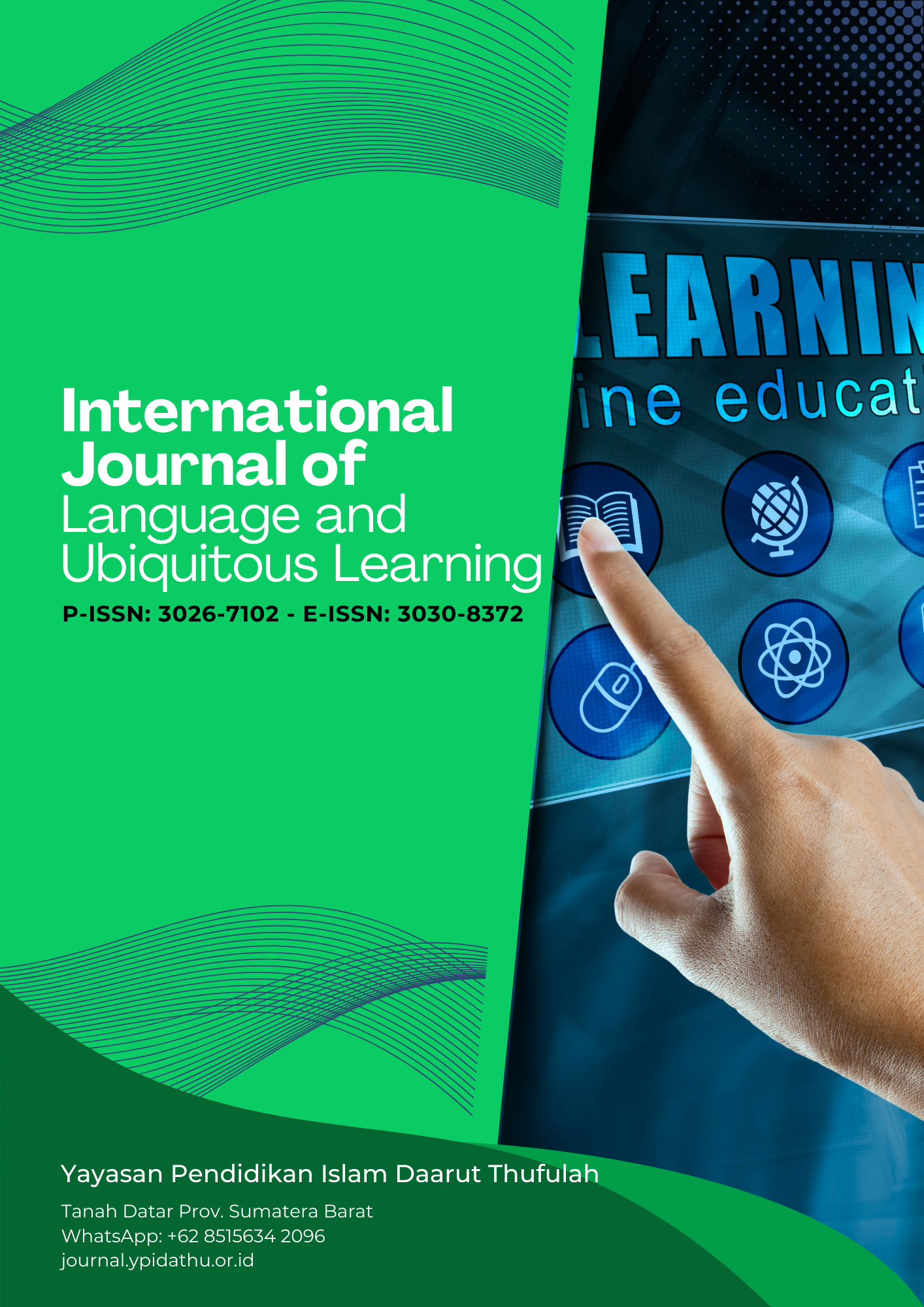The Influence Of The Teacher's Ability To Use Computer-Based Media On Student Attention In Islamic Religious Education Learning At Public Junior High School (SMPN) 2 Sidrap
Abstract
Background. Computer-based media enhances material acceptance and retention, facilitating teachers in efficient material storage and direct student engagement. Utilizing visuals and audio, it directly appeals to sight and hearing senses. Hence, the research titled "Effect of Computer-based Media Proficiency on Attention in Islamic Religious Education for Class VIII at Public Junior High School 2 Sidrap" is pertinent.
Purpose. Based on some of these definitions both linguistically and in terms, teachers can be understood as people who are responsible for the development of students. Where the task of a teacher is to educate, namely to strive for the development of all the potential of students, both cognitive potential, affective potential and psychomotor potential.
Method. This field research employs direct data collection and observation from respondents, falling under the quantitative category for obtaining objective, valid, and reliable numerical or scaled data. Utilizing associative research methods, its focus lies in establishing relationships between two or more variables.
Results. The distributed questionnaires among students at Public Junior High School 2 Sidrap Regency revealed diverse attitudes toward the teacher's proficiency in utilizing computer-based learning media for Islamic Religious Education. Descriptive statistical analysis was employed to present and summarize the data through frequency distribution tables, aiming to provide a comprehensive overview aligned with the research objectives and variable descriptions.
Conclusion. The study concludes that, based on questionnaire responses from 97 participants at Public Junior High School 2 Sidrap Regency, the teacher's proficiency in utilizing computer-based media for Islamic Religious Education learning (variable X) is at 79.9%, categorizing it as moderate. This determination is derived from a ratio of 7444 to 9312, signifying the identified criterion.
Full text article
References
Hadith.Abdul, 2006. Psychology in Education. Bandung: Alfabeta. Jacob, L.C. Ary Donald and Asghar, Razavewh.Introduction toResearch Introduction. 1985. 3th Edition New York: Holt, Renehart and Winston.
Khairani. Makmun. 2013. Psychology of Learning.Yogyakarta: Aswaja Pressindo. Kisworo,
Marsudi Wahyu. 2016.Teaching Revolution: Active, Creative Learning, Effective, Fun Pakem. Jakarta: Asik Generation.
Majid, Abdul and Andayani, Dian, 2004.Competency Based Islamic Religious Education. Bandung: Teenage Workshop.
al Maraghi, Ahmad Musthafa. 1993.Terjemahn Tafsir Al Maraghi, volume 6, 2nd Printing, Semarang PT. Karya Toha Putra.
Mulyasa, E. 2007. CurriculumLevel Education Unit.Cet. 3; Bandung: Teenage Workshop.
Mulyasa, E. 2008. Becoming a Professional Teacher, Creating Creative and Fun Learning.Cet. 8; Bandung: Teenage Workshop.
al- Nahlawi, Abdurrahman. 1992. Principles and Methods of Islamic Education, Bandung: CV. Diponegoro.
Nawawi, Hadari. 1995. Social Research Methods. cet.VII; Yogyakarta: Gajah Mada University Press.
Sardiman, A.M. 2011. Interaction and Motivation for Teaching and Learning, Jakarta: Raja Grafindo Persada.
Abad-Segura, E. (2022). Analysis of research on decision making-based on quantitative methods. Revista de Metodos Cuantitativos para la Economia y la Empresa, 34(Query date: 2023-11-30 23:13:48), 118–136. https://doi.org/10.46661/revmetodoscuanteconempresa.5135
Adorjan, A. (2023). Towards a Researcher-in-the-loop Driven Curation Approach for Quantitative and Qualitative Research Methods. Communications in Computer and Information Science, 1850(Query date: 2023-11-30 23:13:48), 647–655. https://doi.org/10.1007/978-3-031-42941-5_58
Aguirre, T. (2022). Challenges for Teachers’ and Students’ Digital Abilities: A Mixed Methods Design Study. Sustainability (Switzerland), 14(8). https://doi.org/10.3390/su14084729
Agustiawan, F. (2022). The Effectiveness of the Problem Based Learning Model with Augmented Reality Media to Enhance Student Critical Thinking Skills in Online Learning. AIP Conference Proceedings, 2468(Query date: 2023-11-30 23:40:50). https://doi.org/10.1063/5.0102689
Ahyanuardi. (2019). Effectiveness of Use Web-Based Learning Media for Information and Communication Technology in Senior High School. Journal of Physics: Conference Series, 1387(1). https://doi.org/10.1088/1742-6596/1387/1/012123
Alismaiel, O. A., Cifuentes-Faura, J., & Al-Rahmi, W. M. (2022). Online Learning, Mobile Learning, and Social Media Technologies: An Empirical Study on Constructivism Theory during the COVID-19 Pandemic. Sustainability, 14(18), 11134. https://doi.org/10.3390/su141811134
Anindita, T. (2020). Effectiveness of using instructional media for learning letters in three and four-year-old children in West and South Jakarta. Psychological Aspects of Student Performance: Learning from Studies in an Indonesian Context, Query date: 2023-11-30 23:40:50, 117–131.
Astuti, M. (2020). The Effectiveness of the Use of Learning Media of Interactive Multimedia in Facial Skin Care Courses. Proceeding - 2020 3rd International Conference on Vocational Education and Electrical Engineering: Strengthening the framework of Society 5.0 through Innovations in Education, Electrical, Engineering and Informatics Engineering, ICVEE 2020, Query date: 2023-11-30 23:40:50. https://doi.org/10.1109/ICVEE50212.2020.9243259
Ahmadi, Abu. 2009. General Psychology. Jakarta: Rineka Cipta. Echols, John M. and Shadily, Hasan. 1996. An English-Indonesian Dorectory.Cet. 23; Jakarta: Gramedia.
Bardach, L. (2020). Smart teachers, successful students? A systematic review of the literature on teachers’ cognitive abilities and teacher effectiveness. Educational Research Review, 30(Query date: 2023-12-04 20:20:13). https://doi.org/10.1016/j.edurev.2020.100312
Dityawati, M. (2019). The Influence of Learning Motivation, Ability of Teachers to Teach, Parental Attention and Learning Facilities in Understanding Material of Regulatory System in Senior High School. Journal of Physics: Conference Series, 1233(1). https://doi.org/10.1088/1742-6596/1233/1/012003
Hannah, N. (2019). Flash Multimedia Application: An e Learning Arabic Language for Mastering Fluency in Reading the Qur’an. 2019 7th International Conference on Cyber and IT Service Management, CITSM 2019, Query date: 2023-11-30 17:26:04. https://doi.org/10.1109/CITSM47753.2019.8965412
Kurniasari, I., Siswono, T. Y. E., Setianingsih, R., & Manoy, J. (2022). Mathematics teacher’s ability in inclusion school made learning media with Canva application. 030020. https://doi.org/10.1063/5.0103020
Salami, O. (2019a). Islamic Religious Education, Identity and the Arabic Language Among University Students in Southwestern Nigeria. Language Maintenance, Revival and Shift in the Sociology of Religion, Query date: 2023-11-03 10:19:44, 170–183.
Salami, O. (2019b). Islamic Religious Education, Identity and the Arabic Language Among University Students in Southwestern Nigeria. Language Maintenance, Revival and Shift in the Sociology of Religion, Query date: 2023-12-01 00:04:44, 170–183.
Authors
Copyright (c) 2023 Muhammad Hijaz Tahir, Muhammad Arsal Hijaz, Sam Hermansyah

This work is licensed under a Creative Commons Attribution-ShareAlike 4.0 International License.





